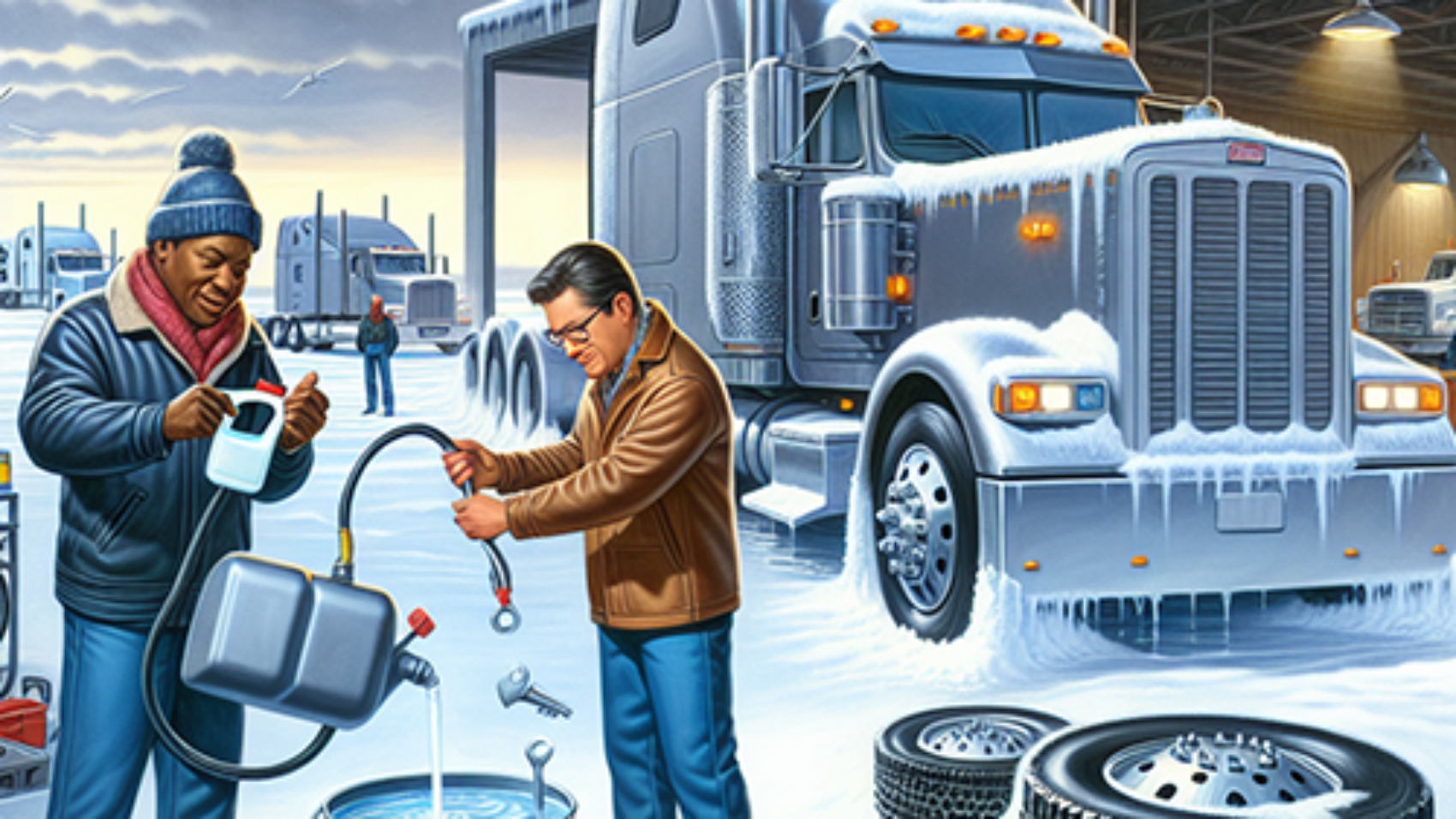When winter approaches, the mere thought of snow, ice, and freezing temperatures can send shivers down any truck driver’s spine. Winterizing your truck isn’t just about avoiding delays; it’s about ensuring safety and smooth operations during those cold months.
Let’s jump into the various things you can do for winterizing your truck inside and out.
Truck PM Service
You should be regularly scheduling your oil change PM every 25,000 miles, but it’s a good idea to either schedule a PM or if you are able to go through your truck components yourself going into winter. Check your seals for cracks, look for leaks and make sure your brakes are in alignment.
Check Your Battery
When temperatures drop, your battery’s performance can take a hit. A weak battery might leave you stranded on a lonely road with nothing but your thoughts and the howling wind.
Check for any signs of corrosion on the terminals and ensure it’s holding a full charge. If your battery is nearing the end of its life (roughly 2 to 3 years), now’s the time to replace it. An investment in a strong battery today can save you from headaches down the road.
Keep the Engine Warm
A warm engine is a happy engine. Winterizing your truck is especially important in freezing temperatures and starting a cold engine can be tough. Engine block heaters are lifesavers in such conditions as they keep the engine block warm, making it easier to start the truck and reducing engine wear. If your truck doesn’t have one, consider installing it. It’s a small investment, roughly sub $200 for peace of mind during winter starts. Check with your favorite truck shop, mine it Raney’s.
Check the Fuel Filter and Water Separator
Water in your fuel system can spell disaster when temperatures drop. It can freeze and block the fuel line, leaving you stuck. In your daily pre-trip inspection, check the fuel filter and water separator to ensure they’re free of water and debris. Replacing the fuel filter before winter is a good practice to maintain engine performance.
Fuel and Fuel Additives
Diesel fuel can gel up in cold weather, which can clog your fuel system. When you fuel up check the cetane rating of the fuel. The cetane rating is similar to the octane rating in gasoline. In warmer places or in the summer diesel fuel #2 is most common, but in the winter in cold locations look for diesel fuel #1. You might get a slightly lower mpg with diesel fuel #1, but worth it to keep your engine lubricated.
Fuel additives can also be used to prevent fuel gelling or thickening. Look for additives designed to lower the pour point of diesel fuel. It’s an easy and effective way to keep your truck running smoothly in sub-zero temperatures.
Inventory Your Snow Chains
Before winter arrives, inventory your snow chains. Ensure they’re in good condition and easily accessible. Practice putting them on if it’s been a while. You don’t want to be fumbling with chains in a snowstorm while your fingers turn into popsicles. For more information on snow chains see my Commercial Vehicle Tire Chains article. We at Miles 2 Go Transport always say “Chain up to get out of trouble, not into trouble.”
Winter Windshield Wiper Fluid
Visibility is crucial when the snow is falling thick and fast. Regular windshield wiper fluid can freeze in low temperatures. Make sure to fill up with winter-specific wiper fluid designed to withstand freezing temperatures. In the beginning of my trucking career I drove a truck through Colorado that had regular wiper fluid and it froze up making it impossible to clean my windshield and visibility was poor. It was a nightmare to deal with and I wouldn’t recommend that to anyone.
Emergency Kit
An emergency kit is your best friend when Mother Nature throws a tantrum. Realistically these items should be in your truck year round, but especially in the winter. Here’s what you should include:
- Extra Blankets: To keep warm if you’re stuck.
- Warm Garments: Gloves, Scarves, Hats, Thick Socks, Boots
- Non-Perishable Food: Granola bars and canned food for sustenance.
- Water: Always keep a few bottles / gallons handy.
- Flashlight and Batteries: For visibility and signaling for help.
- First Aid Kit: For any minor injuries.
- Tool Kit: Basic tools, Ice Scraper and a Shovel
- Extra Fluids: Winter Windshield Fluid, Coolant, Oil, and Fuel Additives
- Extra Parts: Fuel Filter and Windshield Wipers
Having these essentials on hand can make a world of difference if you find yourself in an emergency situation.
Winter Driving Safety
Winter driving requires a whole new level of caution and awareness. Here are some safety tips to keep in mind:
- Slow and Steady: The adage “slow and steady wins the race” couldn’t be more true in winter. Reduced speed can prevent skids and accidents on icy roads.
- Keep Your Distance: Increase the gap between you and the vehicle ahead. It takes longer to stop on slippery surfaces.
- Stay Informed: Keep an eye on weather forecasts. Knowing what lies ahead can help you plan your journey better.
Final Thoughts
Winter doesn’t have to be a nightmare for truck drivers. With a little preparation and attention to detail, you can ensure that your truck is ready to tackle the winter months head-on. Remember, safety is paramount, and a well-maintained truck is the first step towards a safe journey. So, take the time to winterize your rig and enjoy the beauty of the snowy landscapes from the comfort of your warm cabin. Keep the Shiny Side Up!
If you enjoyed this article, please check out our other articles and stories in our blog.

